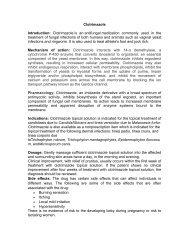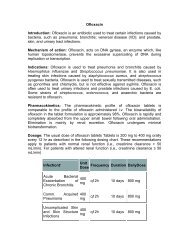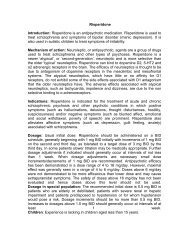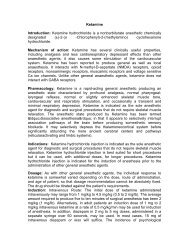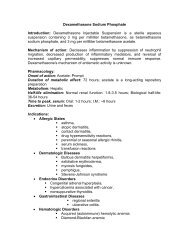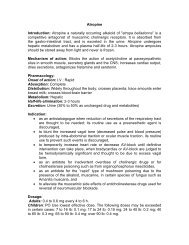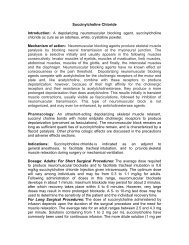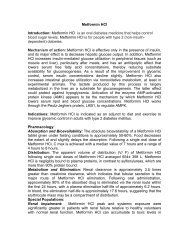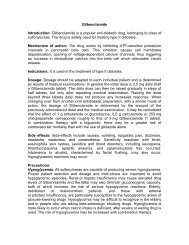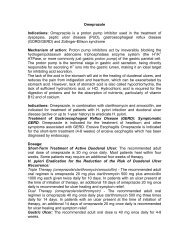Ranitidine Introduction - Pharma Manufacturer
Ranitidine Introduction - Pharma Manufacturer
Ranitidine Introduction - Pharma Manufacturer
You also want an ePaper? Increase the reach of your titles
YUMPU automatically turns print PDFs into web optimized ePapers that Google loves.
Gastrointestinal: Constipation, diarrhea, nausea/vomiting, abdominal<br />
discomfort/pain, and rare reports of pancreatitis.<br />
Hepatic: There have been occasional reports of hepatocellular, cholestatic, or<br />
mixed hepatitis, with or without jaundice. In such circumstances, ranitidine should<br />
be immediately discontinued. These events are usually reversible, but in rare<br />
circumstances death has occurred. Rare cases of hepatic failure have also been<br />
reported. In normal volunteers, SGPT values were increased to at least twice the<br />
pretreatment levels in 6 of 12 subjects receiving 100 mg q.i.d. intravenously for 7<br />
days, and in 4 of 24 subjects receiving 50 mg q.i.d. intravenously for 5 days.<br />
Musculoskeletal: Rare reports of arthralgias and myalgias.<br />
Hematologic: Blood count changes (leukopenia, granulocytopenia, and<br />
thrombocytopenia) have occurred in a few patients. These were usually<br />
reversible. Rare cases of agranulocytosis, pancytopenia, sometimes with marrow<br />
hypoplasia, and aplastic anemia and exceedingly rare cases of acquired immune<br />
hemolytic anemia have been reported.<br />
Endocrine: Controlled studies in animals and man have shown no stimulation of<br />
any pituitary hormone by <strong>Ranitidine</strong> and no antiandrogenic activity, and<br />
cimetidine-induced gynecomastia and impotence in hypersecretory patients have<br />
resolved when <strong>Ranitidine</strong> has been substituted. However, occasional cases of<br />
gynecomastia, impotence, and loss of libido have been reported in male patients<br />
receiving <strong>Ranitidine</strong>, but the incidence did not differ from that in the general<br />
population.<br />
Integumentary: Rash, including rare cases of erythema multiforme. Rare cases<br />
of alopecia and vasculitis.<br />
Respiratory: A large epidemiological study suggested an increased risk of<br />
developing pneumonia in current users of histamine-2-receptor antagonists<br />
(H2RAs) compared to patients who had stopped H2RA treatment, with an<br />
observed adjusted relative risk of 1.63 (95% CI, 1.07-2.48). However, a causal<br />
relationship between use of H2RAs and pneumonia has not been established.<br />
Other: Rare cases of hypersensitivity reactions (e.g., bronchospasm, fever, rash,<br />
eosinophilia), anaphylaxis, angioneurotic edema, and small increases in serum<br />
creatinine.<br />
Precautions:<br />
• Symptomatic response to therapy with <strong>Ranitidine</strong> does not preclude the<br />
presence of gastric malignancy.<br />
• Since <strong>Ranitidine</strong> is excreted primarily by the kidney, dosage should be<br />
adjusted in patients with impaired renal function<br />
• . Caution should be observed in patients with hepatic dysfunction since<br />
<strong>Ranitidine</strong> is metabolized in the liver.<br />
• Rare reports suggest that <strong>Ranitidine</strong> may precipitate acute porphyric<br />
attacks in patients with acute porphyria. <strong>Ranitidine</strong> should therefore be<br />
avoided in patients with a history of acute porphyria.<br />
Carcinogenesis, Mutagenesis, Impairment of Fertility: There was no<br />
indication of tumorigenic or carcinogenic effects in life-span studies in mice and<br />
rats at dosages up to 2,000 mg/kg per day.



